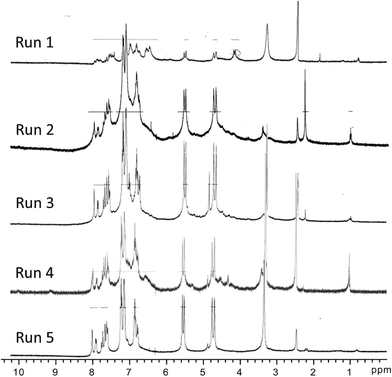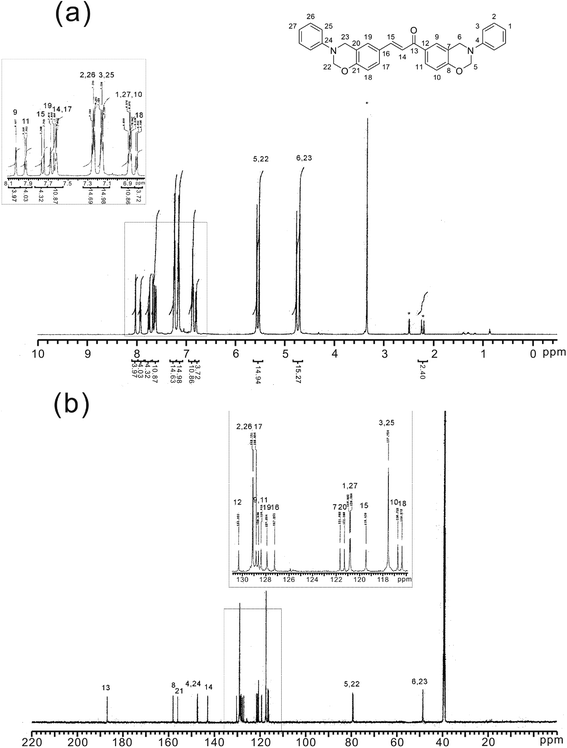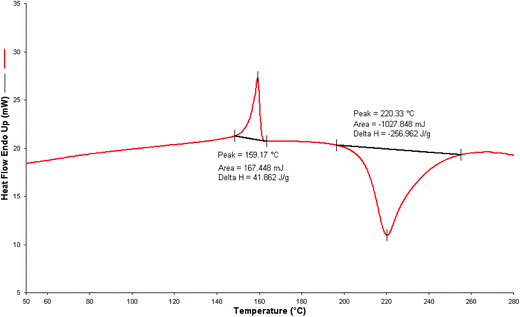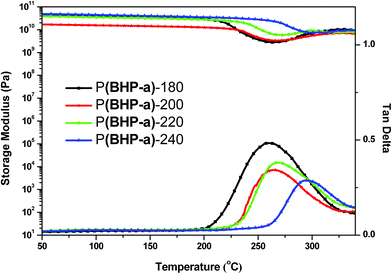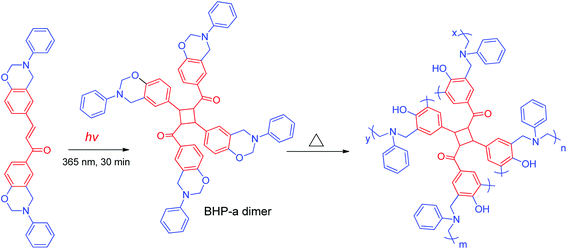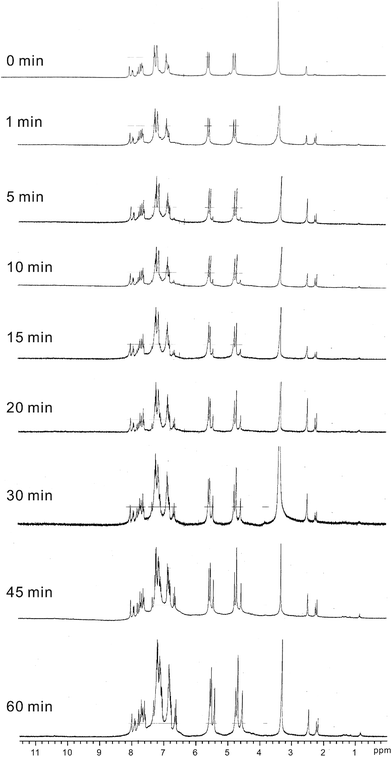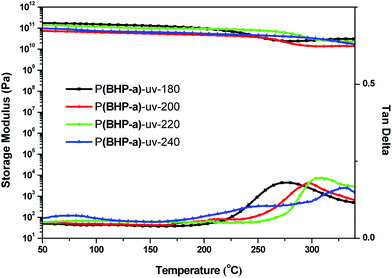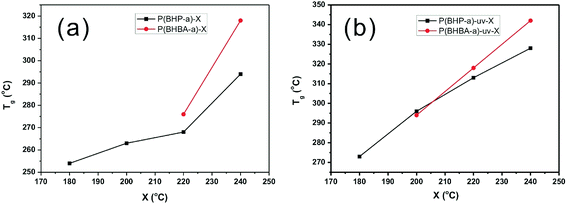 Open Access Article
Open Access ArticleCreative Commons Attribution 3.0 Unported Licence
Photo-sensitive benzoxazine II: chalcone-containing benzoxazine and its photo and thermal-cured thermoset†
Ching Hsuan Lin *a,
Chun Kai Chiena,
Chien Han Chena and
Tzong Yuan Juang*b
*a,
Chun Kai Chiena,
Chien Han Chena and
Tzong Yuan Juang*b
aDepartment of Chemical Engineering, National Chung Hsing University, Taichung, Taiwan. E-mail: linch@nchu.edu.tw
bDepartment of Cosmeceutics, China Medical University, Taichung, Taiwan
First published on 1st August 2017
Abstract
A chalcone-containing benzoxazine (BHP-a) was synthesized from a chalcone-containing bisphenol: 1,3-bis(4-hydroxyphenyl) propanone (BHP), aniline and paraformaldehyde in a co-solvent of xylene/1-butanol (2/1, V/V). The structure of BHP-a was successfully confirmed by FTIR, 1H and 13C-NMR spectra. After thermal treatment at a temperature higher than 240 °C, BHP becomes insoluble. This indicates that the double bond of the chalcone moiety of BHP can be thermally polymerized at elevated temperature. The UV spectrum shows that the chalcone moiety of BHP-a underwent dimerization via [2π + 2π] cycloaddition. Therefore, two procedures were applied to cure BHP-a. The first one was thermal curing of chalcone and oxazine moieties of BHP-a. The second one was photo curing of the chalcone moiety, followed by thermal curing of the oxazine moiety. The thermal properties of thermosets based on the two procedures were evaluated. Thermosets of BHP-a exhibit a Tg as high as 294 °C for curing procedure one, and 328 °C for curing procedure two. The value is much higher than that of a traditional bisphenol/aniline-based benzoxazine thermoset. We conclude that the curing of the double bond of the chalcone and photo dimerization of the chalcone contribute to the good thermal properties.
Introduction
Polybenzoxazines are a class of phenolic thermosets, and are generally obtained by the thermal ring-opening polymerization of benzoxazine monomers. Polybenzoxazines exhibit special characteristics such as moderate-to-high thermal properties,1–14 superior membrance properties at elevated temperatures,15 low shrinkage,16 and low surface energy.17 To further enhance their properties, studies on the curing mechanism,5,7,18–21 incorporation of a multifunctional linkage22–25 or photo-sensitive moieties such as methacryloyl26,27 and coumarins28–30 have been applied. It is known that the coumarin moiety undergoes dimerization through [2π + 2π] cycloaddition to afford a crosslinked network upon irradiation at wavelengths greater than 310 nm. Based on that chemistry, Yagci et al. synthesized a coumarin-containing benzoxazine, 4-methyl-9-p-tolyl-9,10-dihydrochromeno[8,7-e][1,3]oxazin-2(8H)-one,28 and studied the photodimerization of the coumarin moiety. Dimers of different isomers were obtained through the [2π + 2π] cyclobutane formation. Benzoxazine moieties can be polymerized through thermal ring-opening polymerization to afford highly dense crosslinked networks. Kuo et al. prepared a coumarin-containing benzoxazine (coumarin-Py Bz).29,30 They dimerized the coumarin-Py Bz to a dimer, the di-coumarin-Py Bz, through photodimerization of the coumarin moiety. DSC thermograms revealed that the glass transition temperature of poly(di-coumarin-Py BZ) is 227 °C, which is higher than that (200 °C) of poly(coumarin-Py BZ), a thermoset of coumarin-Py Bz without photodimerization. Yagci et al. prepared a series of poly(propylene oxides) bearing coumarin-benzoxazine units (PPO-Cou-Benz)s.31 The coumarin moiety undergoes efficient dimerization upon irradiation at wavelengths higher than 300 nm as confirmed by UV-Vis spectral investigations. Experimental data show that it is possible to trigger self-healing in polybenzoxazine networks that are chemically bound to PPOs.Recently, we have reported the synthesis of a bis(4-hydroxybenzylidene)acetone/aniline-based benzoxazine (BHBA-a, n = 1 in Scheme 1) and studied its photo- and thermally-curing behavior.32 BHBA- was photo-cured to afford a tetrafunctional benzoxazine (BHBA-a dimer), and followed by thermal curing of the double bond and oxazine linkage. The resulting thermoset shows a Tg value as high as 342 °C was achieved.
 | ||
| Scheme 1 Structure of benzoxazines. The value n = 1 for BHBA-a (previous work),32 and n = 0 for BHP-a (this work). | ||
In addition to (meth)acrylate, coumarin and bisbenzylideneacetone moieties, chalcone is also a photo-sensitive moiety. It is an aromatic enone (α,β-unsaturated carbonyl) that can be prepared by aldol condensation between a benzaldehyde and acetophenone in the presence of a base such as sodium hydroxide or BF3·OEt2 as a catalyst.33 Polymers with chalcone moiety possess photo-reactivity. For example, Feng et al.34 and Song et al.35 incorporated chalcone moiety into polyimides. The resulting polyimides showed photosensitivity upon light irradiation using a xenon lamp. Rehab et al.,36 Nanjundan et al.,37 and Kannan et al.38 prepared methacrylate homopolymer with chalcone moiety, and crosslinked them by forming a cyclobutane ring after UV irradiation. Li et al. prepared a fluorinated chalcone-containing poly (arylene ether)39 and poly(arylene ether sulfone).40 They found that thermal properties and the Young's modulus increase after photo curing. Choi et al. prepared chalcone-containing epoxy.41 They found that the cured chalcone-containing epoxy thermoset displayed a higher glass transition temperature and thermal stability than those of cured bisphenol epoxy without chalcone moiety.
To the best of our knowledge, no chalcone-containing benzoxazine has been reported in literature. Continuing other's and our effort in developing photo-sensitive benzoxazines,28–32 we prepared a chalcone-containing benzoxazine, the 1,3-bis(4-hydroxyphenyl) propanone/aniline/formaldehyde-based benzoxazine (BHP-a, n = 0 in Scheme 1) and evaluated the properties of its thermosets. Solubility test shows that the double bond of chalcone is thermally reactive. Therefore, two procedures were applied to cure BHP-a. The first one was thermal curing of the chalcone and oxazine moieties of BHP-a. The second one was photo curing of the chalcone moiety, followed by thermal curing of the oxazine moiety. Thermal properties of thermosets based on the two procedures were evaluated. Detailed syntheses and analysis are reported.
Experimental
Materials
4-Hydroxybenzaldehyde (from Acros), 4-hydroxyacetophenone (from Alfa), and boron trifluoride diethyl etherate (BF3·OEt2, from Alfa), aniline (from Acros), paraformaldehyde (from Pareac) and all solvents (HPLC grade) were purchased from various commercial sources and used without further purification.Characterization
NMR measurements were performed using a Varian Inova 600 NMR in DMSO-d6, and the chemical shift was calibrated by setting the chemical shift of DMSO-d6 at 2.49 ppm. Thermogravimetric analysis (TGA) was performed with a Perkin-Elmer Pyris1 at a heating rate of 20 °C min−1 in an atmosphere of nitrogen or air. Differential scanning calorimetry (DSC) scans were obtained using a Perkin-Elmer DSC 7 in a nitrogen atmosphere at a heating rate of 10 °C min−1. Dynamic mechanical analysis (DMA) was performed using a Perkin-Elmer Pyris Diamond DMA with a sample size of 5.0 cm × 1.0 cm × 0.2 cm. The storage modulus E′ and tan![[thin space (1/6-em)]](https://www.rsc.org/images/entities/char_2009.gif) δ were determined as the sample was subjected to the temperature scan mode at a programmed heating rate of 5 °C min−1 at a frequency of 1 Hz. The test was performed using a bending mode with an amplitude of 5 μm. UV spectra were obtained using UV WinLab Lambda 25. IR spectra were obtained from at least 32 scans in the standard wavenumber range of 667–4000 cm−1 using a Perkin-Elmer RX1 infrared spectrophotometer.
δ were determined as the sample was subjected to the temperature scan mode at a programmed heating rate of 5 °C min−1 at a frequency of 1 Hz. The test was performed using a bending mode with an amplitude of 5 μm. UV spectra were obtained using UV WinLab Lambda 25. IR spectra were obtained from at least 32 scans in the standard wavenumber range of 667–4000 cm−1 using a Perkin-Elmer RX1 infrared spectrophotometer.
![[double bond, length as m-dash]](https://www.rsc.org/images/entities/char_e001.gif) C stretch), 1648 cm−1 (C
C stretch), 1648 cm−1 (C![[double bond, length as m-dash]](https://www.rsc.org/images/entities/char_e001.gif) O stretch), 3325 cm−1 (OH stretch), UV-VIS λmax (C2H5OH) = 351 nm (–C
O stretch), 3325 cm−1 (OH stretch), UV-VIS λmax (C2H5OH) = 351 nm (–C![[double bond, length as m-dash]](https://www.rsc.org/images/entities/char_e001.gif) C–).
C–).![[double bond, length as m-dash]](https://www.rsc.org/images/entities/char_e001.gif) C stretch), 1648 cm−1 (C
C stretch), 1648 cm−1 (C![[double bond, length as m-dash]](https://www.rsc.org/images/entities/char_e001.gif) O stretch). A melting peak at 159 °C with an enthalpy of 41.8 J g−1, and an exothermic peak at 220 °C with an enthalpy of 257 J g−1 were observed in the DSC thermogram.
O stretch). A melting peak at 159 °C with an enthalpy of 41.8 J g−1, and an exothermic peak at 220 °C with an enthalpy of 257 J g−1 were observed in the DSC thermogram.Sample preparation and curing procedure
Results and discussion
Synthesis and characterization of BHP
In generally, a base such as sodium hydroxyl is traditionally used as a catalyst for the formation of chalcone moiety, but the yield and purity is not satisfied. Narender et al. reported that boron trifluoride diethyl etherate (BF3·OEt2) lead to a faster reaction with better purity.33 In this work, BHP was then prepared from 4-hydroxybenzaldehyde and 4-hydroxyacetophenone using BF3·OEt2 as the catalyst (Scheme 2).42 The characteristic peaks of CH![[double bond, length as m-dash]](https://www.rsc.org/images/entities/char_e001.gif) CH in BHP at 7.61 and 7.67 ppm, and the signal of phenolic OH at 10.02 and 10.34 ppm were observed in the 1H-NMR spectrum. The characteristic peaks of CH
CH in BHP at 7.61 and 7.67 ppm, and the signal of phenolic OH at 10.02 and 10.34 ppm were observed in the 1H-NMR spectrum. The characteristic peaks of CH![[double bond, length as m-dash]](https://www.rsc.org/images/entities/char_e001.gif) CH in BHP at 143 and 118 ppm, and the signal of carbonyl at 187 ppm were observed in the 13C-NMR spectrum. Through the 1H–1H COSY and 1H–13C HERCOR (Fig. S1 and S2†), the signals of aromatic hydrogen (H2, H3, H9, and H10) and aromatic carbons (C1–C4, C8–C11) can be correctly assigned. A sharp melting point at 204 °C with an enthalpy of 132 J g−1 was observed in the DSC thermogram. Analytic data show that BHP was successfully prepared.
CH in BHP at 143 and 118 ppm, and the signal of carbonyl at 187 ppm were observed in the 13C-NMR spectrum. Through the 1H–1H COSY and 1H–13C HERCOR (Fig. S1 and S2†), the signals of aromatic hydrogen (H2, H3, H9, and H10) and aromatic carbons (C1–C4, C8–C11) can be correctly assigned. A sharp melting point at 204 °C with an enthalpy of 132 J g−1 was observed in the DSC thermogram. Analytic data show that BHP was successfully prepared.
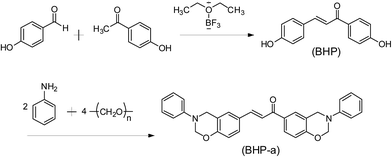 | ||
| Scheme 2 Synthesis of 1,3-bis(4-hydroxyphenyl) propanone (BHP) and BHP/aniline/formaldehyde-based benzoxazine (BHP-a). | ||
Synthesis and characterization of benzoxazine (BHP-a)
BHP-a was prepared by Mannich condensation of (BHP), aniline and formaldehyde (Scheme 2). Fig. 1 shows the 1H-NMR spectra of the reaction product prepared in different reaction media. The effect of reaction media on the purity of BHP-a is discussed. Reacting in 1,4-dioxane (Run 1), a common solvent for Mannich condensation, at 80 °C for 12 h leads to low conversion and byproducts. Using toluene/ethanol as solvents (volume ratio 2/1, 1/1, and 1/2 for Runs 2–4) at 80 °C for 12 h leads to better conversion, but the ratio of the integral area to Ar–H/oxazine is far from the theoretical ratio of 4.5. The co-solvent of toluene/ethanol was a recommended medium for Mannich condensation in our previous work for benzoxazine synthesis.43 Thus, we thought that an incomplete reaction was due to the electron-withdrawing carbonyl group of BHP that reduces the reactivity of phenolic OH. To increase the reaction rate, a co-solvent for a higher temperature reaction was applied. The co-solvent was changed to xylene/1-butanol (V/V = 2/1), and reacting at 100 °C for 12 h (Run 5). As expected, the NMR spectrum shows that increasing the reaction temperature lead to BHP-a with a higher yield and purity (detailed NMR analysis will be discussed in Fig. 2).Fig. 2 shows the (a) 1H-NMR and (b) 13C-NMR spectra of BHP-a. Since the two oxazine linkage in BHP-a was asymmetrical, the oxazine signals split slightly due to the different chemical environment. In Fig. 2a, the characteristic peaks of oxazine at 4.71 and 4.78 ppm (H23 and H6), 5.53 and 5.58 ppm (H22 and H5) were clearly observed. In addition, no signal of phenolic OH was observed, suggesting that the Mannich condensation was complete. In Fig. 2b, the characteristic peaks of oxazine at 48.77 and 48.82 ppm (C23 and C6), 79.31 and 79.56 ppm (C22 and C5) were observed. Through 1H–1H COSY (Fig. S3†) and 1H–13C HERCOR (Fig. S4†), the signals of aromatic hydrogen and aromatic carbons were correctly assigned. Fig. 3 shows the DSC heating thermogram of BHP-a. A sharp melting point at 159 °C with an delta enthalpy of 41 J g−1, followed by an exothermic peak at 220 °C with delta enthalpy of 257 J g−1 were observed. The sharp melting point demonstrate the purity of BHP-a. Since the melting point and exothermic peak temperature of BHP-a are 159 and 220 °C, respectively, the processing window is about 60 °C.
Thermal properties of thermally-cured poly(BHP-a)
Fig. S5† shows a photo of BHP in DMSO after thermal treatment at various temperatures for 20 min. BHP is soluble in DMSO until it is thermally treated at temperature higher than 240 °C, suggesting that a crosslinking structure is formed. It is known that photo-crosslinking of chalcone leads to a dimer with a cyclobutane structure. However, dimerization will not lead to a crosslinking structure. This result indicates that the double bond of chalcone, like general vinyl compounds, can be polymerized through thermal treatment. Therefore, there are two thermally curable moieties in BHP-a. The first one is the double bond of chalcone (marked in red in Scheme 3), and the second one is benzoxazine (marked in blue in Scheme 3). Fig. 4 shows DMA thermograms of the thermosets for BHP-a, the P(BHP-a)-X, in which the X is the final curing temperature. Tg values taken from the peak temperature of tan![[thin space (1/6-em)]](https://www.rsc.org/images/entities/char_2009.gif) δ are 254, 263, 268, and 294 °C for X as 180, 200, 220 and 240, respectively (Table 1). The peak intensity (height) of tan
δ are 254, 263, 268, and 294 °C for X as 180, 200, 220 and 240, respectively (Table 1). The peak intensity (height) of tan![[thin space (1/6-em)]](https://www.rsc.org/images/entities/char_2009.gif) δ decreases gradually with the curing temperature, suggesting that the rigidity increases with the increase in curing temperature. The Tg values of the P(BHP-a)-X and P(BHBA-a)-X32 were plotted in Fig. 8a. The difference between P(BHBA-a)-220 and P(BHP-a)-220 was 8 °C, and was 24 °C between P(BHBA-a)-240 and P(BHP-a)-240. We think that BHBA-a has one more unsaturated double bond than BHP-a, leading to a higher crosslinking density, and thus a higher Tg. Although the Tg value (294 °C) of P(BHP-a)-240 is slightly lower than that (318 °C) of P(BHBA-a)-240,32 the value of 294 °C is much higher than that (around 150–160 °C) of a thermoset of bisphenol-based benzoxazines such as bisphenol A/aniline-based poly(B-a), and bisphenol F/aniline-based poly(F-a).1,2 The high Tg value supports the crosslinking of the double bond of chalcone in BHP-a. Table 1 lists the thermal stability data of P(BHP)-X. Thermal stability increases with the increase in curing temperature, probably due to the increasing degree of curing. P(BHP-a)-240 has a 5 wt% decomposition temperature at 431 °C in nitrogen atmosphere, and 435 °C in air atmosphere, and with a char yield at 800 °C is as high as 68% in nitrogen atmosphere. Generally, thermosets of bisphenol-based benzoxazines such as bisphenol A/aniline-based, and bisphenol F/aniline-based benzoxazine exhibit 5 wt% decomposition temperature at around 300–350 °C.1,2 The high decomposition temperature of P(BHP-a) is impressive.
δ decreases gradually with the curing temperature, suggesting that the rigidity increases with the increase in curing temperature. The Tg values of the P(BHP-a)-X and P(BHBA-a)-X32 were plotted in Fig. 8a. The difference between P(BHBA-a)-220 and P(BHP-a)-220 was 8 °C, and was 24 °C between P(BHBA-a)-240 and P(BHP-a)-240. We think that BHBA-a has one more unsaturated double bond than BHP-a, leading to a higher crosslinking density, and thus a higher Tg. Although the Tg value (294 °C) of P(BHP-a)-240 is slightly lower than that (318 °C) of P(BHBA-a)-240,32 the value of 294 °C is much higher than that (around 150–160 °C) of a thermoset of bisphenol-based benzoxazines such as bisphenol A/aniline-based poly(B-a), and bisphenol F/aniline-based poly(F-a).1,2 The high Tg value supports the crosslinking of the double bond of chalcone in BHP-a. Table 1 lists the thermal stability data of P(BHP)-X. Thermal stability increases with the increase in curing temperature, probably due to the increasing degree of curing. P(BHP-a)-240 has a 5 wt% decomposition temperature at 431 °C in nitrogen atmosphere, and 435 °C in air atmosphere, and with a char yield at 800 °C is as high as 68% in nitrogen atmosphere. Generally, thermosets of bisphenol-based benzoxazines such as bisphenol A/aniline-based, and bisphenol F/aniline-based benzoxazine exhibit 5 wt% decomposition temperature at around 300–350 °C.1,2 The high decomposition temperature of P(BHP-a) is impressive.
| Sample ID | tan![[thin space (1/6-em)]](https://www.rsc.org/images/entities/char_2009.gif) δ (°C) (DMA)a δ (°C) (DMA)a |
Td5%b (oC) | Char yieldc (%) | ||
|---|---|---|---|---|---|
| N2 | air | N2 | air | ||
a Measured by DMA at a heating rate of 5 °C min−1; Tg were determined from a peak temperature of the tan![[thin space (1/6-em)]](https://www.rsc.org/images/entities/char_2009.gif) δ curve.b Temperature corresponding to 5% weight loss by thermogravimetry at a heating rate of 20 °C min−1 in nitrogen and air.c Residual weight% at 800 °C in nitrogen and air. δ curve.b Temperature corresponding to 5% weight loss by thermogravimetry at a heating rate of 20 °C min−1 in nitrogen and air.c Residual weight% at 800 °C in nitrogen and air. |
|||||
| P(BHP-a)-180 | 254 | — | — | — | — |
| P(BHP-a)-200 | 263 | 395 | 408 | 67 | 0 |
| P(BHP-a)-220 | 268 | 414 | 412 | 67 | 0 |
| P(BHP-a)-240 | 294 | 431 | 435 | 68 | 0 |
| P(BHP-a)-UV-180 | 273 | — | — | — | — |
| P(BHP-a)-UV-200 | 296 | 335 | 349 | 58 | 0 |
| P(BHP-a)-UV-220 | 313 | 373 | 379 | 62 | 0 |
| P(BHP-a)-UV-240 | 328 | 378 | 392 | P60 | 0 |
Thermal properties of UV and thermally-cured poly(BHP-a)
Fig. 5 shows the UV absorption spectra of BHP-a in DMAc (10−2 M) after irradiating at 365 nm for various periods of time. An isosbestic point at 300 nm, a π–π* absorption of a double bound of chalcone at 334 nm, and a δ–δ* absorption of cyclobutane at 281 nm were observed. The intensity of the π–π* absorption decreases with the irradiation time, and the δ–δ* absorption increases with the irradiation time. The UV absorption data indicate the formation of a BHP-a dimer, as shown in Scheme 4.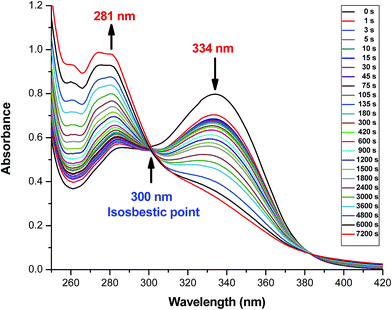 | ||
| Fig. 5 UV absorption spectra of BHP-a in DMAc (10−2 M) after irradiating at 365 nm for various periods of time. | ||
Fig. 6 shows the 1H-NMR spectra of BHP-a after irradiating at 365 nm for various periods of time. Two new absorptions at 4.6 and 5.4 ppm corresponding to the cyclobutane structure in BHP-a dimer appear after irradiating for 5 min. This new absorption of cyclobutane is consistent with that of the UV analysis (Fig. 6). The signals for oxazine at 4.7 and 5.6 ppm are intact open UV irradiation, suggesting that the oxazine is stable under the UV irradiation we have applied. Scheme 4 shows the photo-curing of BHP-a, followed by thermally curing. The oxazines of BHP-a dimer can be thermally-cured, leading to P(BHP-a)-UV-X.
Fig. 7 shows DMA thermograms of P(BHP-a)-UV-X, in which X is the final curing temperature. Tg values taken from the peak temperature of tan![[thin space (1/6-em)]](https://www.rsc.org/images/entities/char_2009.gif) δ are 273, 296, 313, and 328 °C for X as 180, 200, 220, and 240, respectively. The Tg value of P(BHP-a)-UV-X is higher than that of P(BHP-a)-X, indicating that the BHP-a dimer, a tetra-functional benzoxazine, contributes to a higher crosslinking density.29 The peak intensity (height) of tan(delta) in Fig. 7 is much less than that in Fig. 4, further demonstrating a higher crosslinking density for P(BHP-a)-UV-X. The Tg values of the P(BHP-a)-UV-X and P(BHBA-a)-UV-X32 were plotted in Fig. 8b. The difference between P(BHBA-a)-UV-220 and P(BHP-a)-UV-220 was 5 °C, and was 14 °C between P(BHBA-a)-UV-240 and P(BHP-a)-UV-240. We speculate the one more unsaturated double bond in BHBA-a dimer than BHP-a dimer,32 leading to a higher crosslinking density at high curing temperature. Therefore, the gap increase slightly with the curing temperature. TGA thermogram shows that the 5 wt% decomposition temperature of P(BHP-a)-UV-240 is 378 °C in a nitrogen atmosphere, and 392 °C in an air atmosphere, and with char yield at 800 °C in nitrogen atmosphere as high as 60% in nitrogen atmosphere. The thermal stability of P(BHP-a)-UV-X is slightly lower than P(BHP-a)-X, probably due to the less thermal stability of cyclobutane moiety or the degradation of polymer chains during UV irradiation.
δ are 273, 296, 313, and 328 °C for X as 180, 200, 220, and 240, respectively. The Tg value of P(BHP-a)-UV-X is higher than that of P(BHP-a)-X, indicating that the BHP-a dimer, a tetra-functional benzoxazine, contributes to a higher crosslinking density.29 The peak intensity (height) of tan(delta) in Fig. 7 is much less than that in Fig. 4, further demonstrating a higher crosslinking density for P(BHP-a)-UV-X. The Tg values of the P(BHP-a)-UV-X and P(BHBA-a)-UV-X32 were plotted in Fig. 8b. The difference between P(BHBA-a)-UV-220 and P(BHP-a)-UV-220 was 5 °C, and was 14 °C between P(BHBA-a)-UV-240 and P(BHP-a)-UV-240. We speculate the one more unsaturated double bond in BHBA-a dimer than BHP-a dimer,32 leading to a higher crosslinking density at high curing temperature. Therefore, the gap increase slightly with the curing temperature. TGA thermogram shows that the 5 wt% decomposition temperature of P(BHP-a)-UV-240 is 378 °C in a nitrogen atmosphere, and 392 °C in an air atmosphere, and with char yield at 800 °C in nitrogen atmosphere as high as 60% in nitrogen atmosphere. The thermal stability of P(BHP-a)-UV-X is slightly lower than P(BHP-a)-X, probably due to the less thermal stability of cyclobutane moiety or the degradation of polymer chains during UV irradiation.
Conclusions
We have successfully prepared a bifunctional chalcone-containing benzoxazine (BHP-a) from 1,3-bis(4-hydroxyphenyl) propanone (BHP), aniline and paraformaldehyde in a co-solvent of xylene/1-butanol (V/V = 2/1) (Fig. 1). The double bond of chalcone is thermally reactive, as evidenced by the insolubility of BHP after thermal treatment at temperatures 240 °C for 20 min (Fig. S5†). The chalcone moiety can be photo-cured to afford a tetrafunctional benzoxazine, BHP-a dimer, as supported by the UV absorption (Fig. 5) and 1H-NMR (Fig. 6) spectra. Therefore, two curing procedures were applied for BHP-a to afford the thermosets. The first one was thermal curing of the chalcone and oxazine moieties, forming thermosets P(BHP-a)-X. The second one was photo-curing of the chalcone moiety, followed by thermally curing of the oxazine moiety, forming thermosets P(BHP-a)-UV-X. P(BHP-a)-240 exhibit a Tg value as high as 294 °C, according to the DMA thermogram (Fig. 4). The crosslinking of the double bond of chalcone, as shown in Scheme 3, might be responsible for Tg being much higher than that for general polybenzoxazines without chalcone moiety. According to the DMA thermogram (Fig. 7), P(BHP-a)-UV-240 exhibits a Tg value as high as 328 °C. The Tg value of P(BHP-a)-UV-X is higher than that of P(BHP-a)-X, indicating that the BHP-a dimer, a tetra-functional benzoxazine, contributes to a higher crosslinking density. Although the Tg value of P(BHP-a)-X is slightly lower than that of P(BHBA-a)-X,32 probably due to BHBA-a has one more unsaturated double bond than BHP-a, leading to a higher crosslinking density. However, the difference is small. Therefore, incorporating chalcone into benzoxazine appears to be a alternative strategy to afford high-performance benzoxazine thermosets.Acknowledgements
Financial support of this work from the Ministry of Science and Technology (MOST 104-2628-E-005-002-MY3), Taiwan is highly appreciated.Notes and references
- X. Ning and H. Ishida, J. Polym. Sci., Part A: Polym. Chem., 1994, 32, 1121–1129 CrossRef CAS.
- J. Liu and H. Ishida, Macromolecules, 2014, 47, 5682–5690 CrossRef CAS.
- Y. Yagci, B. Kiskan and N. N. Ghosh, J. Polym. Sci., Part A: Polym. Chem., 2009, 47, 5565–5576 CrossRef CAS.
- N. N. Ghosh, B. Kiskan and Y. Yagci, Prog. Polym. Sci., 2007, 32, 1344–1391 CrossRef CAS.
- S. N. Kolanadiyil and T. Endo, Macromolecules, 2016, 49, 8466–8478 CrossRef.
- C. Rodriguez Arza, P. Froimowicz and H. Ishida, RSC Adv., 2015, 5, 97855–97861 RSC.
- A. W. Kawaguchi, A. Sudo and T. Endo, J. Polym. Sci., Part A: Polym. Chem., 2014, 52, 410–416 CrossRef CAS.
- M. Arslan, B. Kiskan and Y. Yagci, Macromolecules, 2015, 48, 1329–1334 CrossRef CAS.
- S. Zhang, P. Yang, Y. Bai, T. Zhou, R. Zhu and Y. Gu, ACS Omega, 2017, 2, 1529–1534 CrossRef CAS.
- S. Li and S. Yan, RSC Adv., 2015, 5, 61808–61814 RSC.
- L. Zhang, Y. Zhu, D. Li, M. Wang, H. Chen and J. Wu, RSC Adv., 2015, 5, 96879–96887 RSC.
- P. Thirukumaran, A. Shakila and S. Muthusamy, RSC Adv., 2014, 4, 7959–7966 RSC.
- Y. Xu, Q. Ran, C. Li, R. Zhu and Y. Gu, RSC Adv., 2015, 5, 82429–82437 RSC.
- K. Zhang, Q. Zhuang, X. Liu, R. Cai, G. Yang and Z. Han, RSC Adv., 2013, 3, 5261–5270 RSC.
- S.-K. Kim, S.-W. Choi, W. S. Jeon, J. O. Park, T. Ko, H. Chang and J.-C. Lee, Macromolecules, 2012, 45, 1438–1446 CrossRef CAS.
- H. Ishida and D. J. Allen, J. Polym. Sci., Part B: Polym. Phys., 1996, 34, 1019–1030 CrossRef CAS.
- C. F. Wang, Y. C. Su, S. W. Kuo, C. F. Huang, Y. C. Sheen and F. C. Chang, Angew. Chem., Int. Ed., 2006, 45, 2248–2251 CrossRef CAS PubMed.
- H. Wang, R. Zhu, P. Yang and Y. Gu, Polym. Chem., 2016, 7, 860–866 RSC.
- R. Kudoh, A. Sudo and T. Endo, Macromolecules, 2010, 43, 1185–1187 CrossRef CAS.
- H. Oie, A. Sudo and T. Endo, J. Polym. Sci., Part A: Polym. Chem., 2010, 48, 5357–5363 CrossRef CAS.
- H. Oie, A. Mori, A. Sudo and T. Endo, J. Polym. Sci., Part A: Polym. Chem., 2012, 50, 4756–4761 CrossRef CAS.
- S. Shukla and B. Lochab, Polymer, 2016, 99, 684–694 CrossRef CAS.
- H. Wang, J. Wang, X. He, T. Feng, N. Ramdani, M. Luan, W. Liu and X. Xu, RSC Adv., 2014, 4, 64798–64801 RSC.
- T. Zhang, J. Wang, T. Feng, H. Wang, N. Ramdani, M. Derradji, X. Xu, W. Liu and T. Tang, RSC Adv., 2015, 5, 33623–33631 RSC.
- J. Wang, W. Liu and T. Feng, in Advanced and Emerging Polybenzoxazine Science and Technology, ed. P. Froimowicz, Elsevier, Amsterdam, 2017, pp. 533–567, DOI:10.1016/b978-0-12-804170-3.00028-7.
- L. Jin, T. Agag, Y. Yagci and H. Ishida, Macromolecules, 2011, 44, 767–772 CrossRef CAS.
- B. Koz, B. Kiskan and Y. Yagci, Polym. Bull., 2011, 66, 165–174 CrossRef CAS.
- B. Kiskan and Y. Yagci, J. Polym. Sci., Part A: Polym. Chem., 2007, 45, 1670–1676 CrossRef CAS.
- M. G. Mohamed, K.-C. Hsu and S.-W. Kuo, Polym. Chem., 2015, 6, 2423–2433 RSC.
- R.-C. Lin, M. G. Mohamed, K.-C. Hsu, J.-Y. Wu, Y.-R. Jheng and S.-W. Kuo, RSC Adv., 2016, 6, 10683–10696 RSC.
- B. Kiskan and Y. Yagci, J. Polym. Sci., Part A: Polym. Chem., 2014, 52, 2911–2918 CrossRef CAS.
- C. H. Lin, Z. J. Chen, C. H. Chen, M. W. Wang and T. Y. Juang, ACS Omega, 2017, 2, 3432–3440 CrossRef CAS.
- T. Narender and K. Papi Reddy, Tetrahedron Lett., 2007, 48, 3177–3180 CrossRef CAS.
- K. Feng, M. Tsushima, T. Matsumoto and T. Kurosaki, J. Polym. Sci., Part A: Polym. Chem., 1998, 36, 685–693 CrossRef CAS.
- D.-m. Song, K.-h. Jung, J.-h. Moon and D.-m. Shin, Opt. Mater., 2003, 21, 667–671 CrossRef CAS.
- A. Rehab and N. Salahuddin, Polymer, 1999, 40, 2197–2207 CrossRef CAS.
- R. Balaji and S. Nanjundan, React. Funct. Polym., 2001, 49, 77–86 CrossRef CAS.
- S. Balamurugan, S. Nithyanandan, C. Selvarasu, G. Y. Yeap and P. Kannan, Polymer, 2012, 53, 4104–4111 CrossRef CAS.
- W. Tie, Z. Zhong, P. Wen, M.-H. Lee and X.-D. Li, Mater. Lett., 2009, 63, 1381–1383 CrossRef CAS.
- W. Tie, Z. Zhong, L. Li, A. Zhang, F. Shen, M.-H. Lee and X.-D. Li, Eur. Polym. J., 2012, 48, 2070–2075 CrossRef CAS.
- D. H. Choi, S. J. Oh, H. B. Cha and J. Y. Lee, Eur. Polym. J., 2001, 37, 1951–1959 CrossRef CAS.
- K. Kaniappan and S. Murugavel, J. Appl. Polym. Sci., 2009, 111, 1606–1614 CrossRef CAS.
- C. H. Lin, S. L. Chang, T. Y. Shen, Y. S. Shih, H. T. Lin and C. F. Wang, Polym. Chem., 2012, 3, 935–945 RSC.
Footnote |
| † Electronic supplementary information (ESI) available: Fig. S1–S5. See DOI: 10.1039/c7ra06967g |
| This journal is © The Royal Society of Chemistry 2017 |



